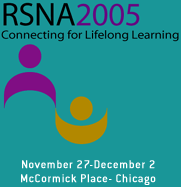
Abstract Archives of the RSNA, 2005
LPD08-05
Changes in Prefrontal N-acetylaspartate Level Correspond to Changes in Neurological Status in Stroke Patients: Two-time Point Proton MRS Study
Scientific Posters
Presented on November 28, 2005
Presented as part of LPD08: Neuroradiology/Head and Neck (Stroke: Diagnosis)
Lidia Glodzik-Sobanska, Presenter: Nothing to Disclose
Jerzy Walecki, Abstract Co-Author: Nothing to Disclose
Agnieszka Slowik, Abstract Co-Author: Nothing to Disclose
Basia Sobiecka, Abstract Co-Author: Nothing to Disclose
Justyna Kozub, Abstract Co-Author: Nothing to Disclose
Andrzej Urbanik MD, Abstract Co-Author: Nothing to Disclose
Functional imaging studies suggest that activation in the prefrontal cortex is consistently related to reorganization associated with post-stroke recovery. Little is known however about longitudinal post-stroke changes in the biochemistry of these regions or how these changes relate to patients’ neurological status. To address these issues, we performed proton magnetic resonance spectroscopy (H1MRS).
31 patients with a first ischemic stroke located outside the frontal lobes were included. H1MRS was performed on a 1.5 T scanner. PRESS sequence was used. N-acetylaspartate/ creatine (NAA)/Cr ratio was measured both in ipsi and contralesional prefrontal cortex in early (9 ± 2 days after stroke) and chronic phase of the disease (110 ± 30 days after). Patients’ neurological status was assessed with Scandinavian Stroke Scale at discharge from the Stroke Unit and during second H1MRS examination.
In the whole group, during the second examination a significant decrease in NAA/Cr ratio was observed in the ipsilesional prefrontal region as compared to the early phase. Different patterns of contralesional NAA/Cr changes were detected in patients who had more or less neurological improvement. In patients with more improvement, contralesional NAA/Cr increased over time. This was not seen in patients with less improvement. Subjects who showed an increase in contralesional NAA/Cr ratio between first and second examination, improved over this time by an average of 9 points in SSS. Subjects in whom contralesional NAA/Cr did not increase improved only by 3.7 points. The mean values for percentage improvements were 25.4% and 8%, respectively. Both differences were highly significant.
The study demonstrated an association between post-stroke changes in neuronal viability marker in non damaged, contralesional associative areas and improvement in patients’ neurological status.
Functional imaging studies suggest that activation in the prefrontal cortex is consistently related to reorganization associated with post-stroke recovery. Little is known however about longitudinal post-stroke changes in the biochemistry of these regions or how these changes relate to patients’ neurological status. To address these issues, we performed proton magnetic resonance spectroscopy (H1MRS).
31 patients with a first ischemic stroke located outside the frontal lobes were included. H1MRS was performed on a 1.5 T scanner. PRESS sequence was used. N-acetylaspartate/ creatine (NAA)/Cr ratio was measured both in ipsi and contralesional prefrontal cortex in early (9 ± 2 days after stroke) and chronic phase of the disease (110 ± 30 days after). Patients’ neurological status was assessed with Scandinavian Stroke Scale at discharge from the Stroke Unit and during second H1MRS examination.
In the whole group, during the second examination a significant decrease in NAA/Cr ratio was observed in the ipsilesional prefrontal region as compared to the early phase. Different patterns of contralesional NAA/Cr changes were detected in patients who had more or less neurological improvement. In patients with more improvement, contralesional NAA/Cr increased over time. This was not seen in patients with less improvement. Subjects who showed an increase in contralesional NAA/Cr ratio between first and second examination, improved over this time by an average of 9 points in SSS. Subjects in whom contralesional NAA/Cr did not increase improved only by 3.7 points. The mean values for percentage improvements were 25.4% and 8%, respectively. Both differences were highly significant.
The study demonstrated an association between post-stroke changes in neuronal viability marker in non damaged, contralesional associative areas and improvement in patients’ neurological status.
Glodzik-Sobanska, L,
Walecki, J,
Slowik, A,
Sobiecka, B,
Kozub, J,
Urbanik, A,
Changes in Prefrontal N-acetylaspartate Level Correspond to Changes in Neurological Status in Stroke Patients: Two-time Point Proton MRS Study. Radiological Society of North America 2005 Scientific Assembly and Annual Meeting, November 27 - December 2, 2005 ,Chicago IL.
http://archive.rsna.org/2005/4415457.html

